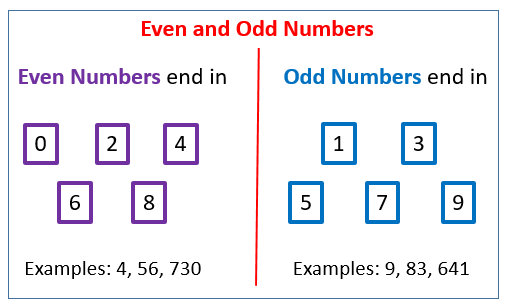Even and odd numbers are subsets of whole numbers in mathematics. Both sets of integers are distinct, and no number can be both even and odd at the same time. There are two types of numbers: even and odd.
Even numbers can be divided by 2 without leaving a remainder, however, when odd numbers are divided by 2, it leaves a remainder.
Odd and Even Numbers Explained
The definition of an even number is that an even number can be split into two equal parts. An odd number, on the other hand, is one that can't be split into two groups of the same size.
Odd and even numbers are also known as:
Even Number: An even number is a number that is divisible by two and has a residual of zero.
Odd Number: A non-divisible of the number two that leaves a remainder of '1'.
Recognizing if a number is even or odd by understanding the number in the "ones" position
The number in the "ones" position of an integer is analyzed to determine whether or not it is even or odd.
Odd numbers include all those ending in 1,3,5,7, and 9. Odd numbers include things like 11, 23, 35, 47, and so on.
Even numbers begin with 0, 2, 4, 6, and 8. Even numbers include such as 4, 16, 32, 80, and 88.
How to understand whether a given number is odd or even?
Recognizing if a number is even or odd can be done by understanding the number in the "ones" position
The number in the "ones" position of an integer is analyzed to determine whether or not it is even or odd.
Odd numbers: Odd numbers include numbers all those ending in 1,3,5,7, and 9. Odd numbers include numbers like 9, 23, 39, 43, 57, and so on.
Even numbers: Even numbers begin with 0, 2, 4, 6, and 8. Even numbers include such as 4, 16, 32, 80, and 88.
Understanding Even and Odd Numbers Properties
Even and odd numbers have the following characteristics:
1. If two even numbers are added together, the result will be an even number.
EVEN (10) + EVEN (2) = EVEN (12)
2. An even number plus an odd number results in an odd number.
EVEN (10) + ODD (1) = ODD (11).
3. Even number is the sum of odd numbers. ODD (25) + ODD (5) = EVEN (30).
4. When you subtract an even number from an even number, you would get an even number. (EVEN) 50- EVEN (10) = EVEN (40).
5. When you subtract an even number from an odd number, you would get Odd number.
ODD - EVEN = ODD.
e.g. 59 - 10 = 49
6. When you subtract an odd number from an odd number, you would get an even number.
ODD - ODD = EVEN.
E.g 51-11=40
7. When you multiply an even number with an odd number, you would get an even number.
EVEN x ODD = EVEN.
E.g. 8 x 7 = 56
8. When you multiply an even number with an even number, you would get an even number.
EVEN x EVEN = EVEN.
E.g. 8 x 8 = 64


